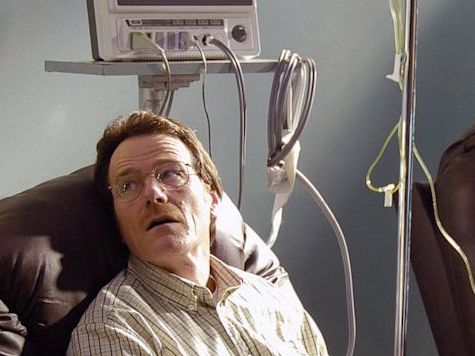
The glitches and problems plaguing the websites of the Obamacare exchanges represent a bigger cancer within the bloated federal government according to the Department of Better Technology (DOBT), which builds software for the government.
This refutes the idea that higher cost implies better quality and effectiveness.
The Obamacare exchanges, which debuted last week, are not as user-friendly as President Barack Obama’s campaign website, even though it cost more to develop than that site and others like Facebook and Twitter with a price tag of more than $634 million. Using a Breaking Bad analogy, DOBT wrote that “worrying about fixing healthcare.gov is a bit like giving Walter White cough syrup and expecting it to solve all his problems.”
“You might hope his cough will go away, but it certainly isn’t going to end his lung cancer nor convince him to shut down his meth empire,” DOBT wrote of the Breaking Bad character.
According to DOBT, “healthcare.gov got this way not because of incompetence or sloppiness of an individual vendor, but because of a deeply engrained and malignant cancer that’s eating away at the federal government’s ability to provide effective online services.”
“It’s a cancer that’s shut out the best and brightest minds from working on these problems, diminished competition for federal work, and landed us here — where you have half-billion dollar websites that don’t work,” DOBT writes.
That cancer is the “procurement” process, and DOBT notes that, “it’s primarily a culture driven cancer” because the government “tries to mitigate so much risk that it all but ensures it.”
“It’s one that allowed for only a handful of companies like CGI Federal to not only build disasters like this, but to keep building more and more failures without any accountability to the ultimate client: us,” they write.
Because contracting officers inside the government “are afraid of their buys being contested by people who didn’t get selected” and “of things going wrong down the line inside of a procurement,” they select vendors with a lot of federal experience on paper to do the work. And, “over time, those vendors have been consolidated into pre-approved lists like GSA’s Alliant schedule. Then, for risk mitigation’s sake, they end up being the only ones allowed to compete for bids.”
“This results in a culturally accepted idea that cost implies quality,” DODT writes. “To ensure no disasters happen, throw lots of money at it. And when things go terribly wrong, throw more money at the same people who caused the problem to fix the problem.”
DODT also points out that the “6,500 pages of regulation, cumbersome business registration processes, and hostile bidding environments ensure that very few new businesses can compete for contracts, and the ones that do end up becoming specialists in those regulatory burdens, not in doing the right thing.”
“In order to solve the healthcare.gov problem, we’ve got to stop worrying about the cough, and start worrying about the cancer,” DODT writes. “We’ve got to start worrying about the systemic issues that allow for healthcare.gov to happen.”

COMMENTS
Please let us know if you're having issues with commenting.